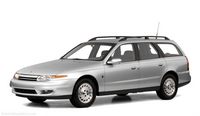New Car/Review
Saturn LW300 (2001)
SEE ALSO: Saturn Buyer's Guide
by Brendan Hagin and Mikele Schappell-Hagin
SPECIFICATIONS
Manufacturer's Suggested Retail Price $ 21,360
Price As Tested $ 23,035
Engine Type DOHC 24-valve 3.0 Liter V6 w/SMFI*
Engine Size 184 cid/3000 cc
Horsepower 182 @ 5600 RPM
Torque (lb-ft) 190 @ 3600 RPM
Wheelbase/Width/Length 106.5"/78.8"/190.4"
Transmission Four-speed automatic
Curb Weight 3432 pounds
Fuel Capacity 15.7 gallons
Tires (F/R) P205/65R15 all-season
Brakes (F/R) Disc (ABS)/disc (ABS)
Drive Train Front-engine/front-wheel-drive
Vehicle Type Five-passenger/five-door
Domestic Content 80 percent
Coefficient of Drag (Cd.) 0.32
PERFORMANCE
EPA Economy, miles per gallon
city/highway/average 20/26/23
0-60 MPH 8.5 seconds
1/4 (E.T.) 17.0 @ 86.5 mph
Top-speed 120 mph
* Sequential multi-port fuel injection
BRENDAN - When Saturn was introduced to the car buying public in the mid-1980s, it was billed as "a different kind of car company." That was true in many ways, because America had not yet produced a Japanese-influenced vehicle that also featured flexible body panels and a no-hassle dealership experience. They sold well, but a lot of drivers had to shop somewhere else for a larger car because the Saturn was just too small. Now that Saturn has introduced its L-Series line, the Saturn fan can remain loyal while moving up to greener pastures and more cargo space. With a more-than-adequate 3.0-liter V-6 engine, the new LW300 wagon really makes sense as a family car and a daily driver. It uses a dual-overhead-cam design and four valves per cylinder to give it the "umph" it needs for merging quickly and easily into traffic.
MIKELE - I loved this car. It shifted like a dream, thanks to the silky-smooth four-speed automatic transmission that monitors driving conditions and adjusts itself for optimum performance. The sport-tuned suspension system uses tight springing, a thick front stabilizer bar for body lean control around corners, and a rear stabilizer bar for understeer control. When I used it to run errands in San Francisco, the power-assisted, ventilated disc brakes with ABS stopped the LW300 with no problem and that put me at ease. Big city driving can mean sudden stops and lots of surprises. I wasn't worried about the nicks and dings that can happen when parking in San Francisco, thanks to the dent-resistant, flexible body panels. They also don't rust or corrode, so a New York City driver could keep this car looking great forever. But unless you're a cabby or a native, I don't recommend driving in downtown Manhattan, period. I love New York, but it's traffic is a zoo.
BRENDAN - I agree with you about the Big Apple. Even though it's inviting, I'd still take the Number 4 train to Yankee Stadium rather than the LW300, simply because I'm a rookie driver in the Bronx. But here in the West, the Saturn's nice leather-wrapped adjustable steering wheel and multi-adjustable power front driver seat allows a big guy like me plenty of legroom while I'm driving. The seat controls were a little confusing, but I got the hang of it soon enough. Woodgrain interior trim brightens the Saturn inside, and for an extra $255, the Saturn Advanced Audio System option uses eight premium speakers, a subwoofer, an amplifier, and a CD changer and cassette player that fill the cabin with crisp sounds. In my opinion, it requires no aftermarket upgrading, and that's not something most of the other car makers can brag about. Front and rear 12-volt power outlets let you plug in a variety of electronics, and the four tough cupholders helped out when we went on long drives that required maximum soda and water consumption. Cargo space was ample, and our two dogs Roxie and Ella fit happily in the back, especially when we laid down the split 60/40 fold down rear seats. The glove box is plenty big, and there is a seat pocket behind each front seat. Two of my only gripes were the hard-to-reach climate controls, and the horn button. It was also hard to locate, not taking up the whole center of the steering wheel like most modern cars.
MIKELE - I liked the inside as well, Bren, but the design of the exterior was what really struck me. I loved its sleek body design and 15-inch alloy wheels that are usually missing from family wagons. Safety-wise, the Saturn has four sets of lap-and-shoulder belts, and driver and passenger airbags. According to the factory, modified steel spaceframe construction almost makes up for the lack of side airbags, the only safety feature missing from our test car. It also featured child-safety seat top tether anchors and rear door child-security locks, good stuff for expecting families like us. You'll really have to practice how to install those seats Bren, because I expect lots of help when we have kids.
BRENDAN - Yes dear.



